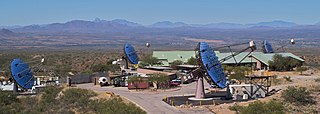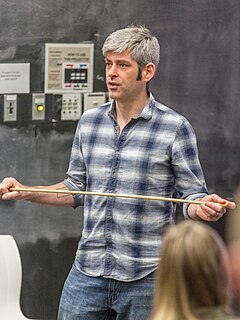The Greisen–Zatsepin–Kuzmin limit (GZK limit) is a theoretical upper limit on the energy of cosmic ray protons traveling from other galaxies through the intergalactic medium to our galaxy. The limit is 5×1019 eV (50 EeV), or about 8 joules (the energy of a proton travelling at ≈99.99999999999999999998% the speed of light). The limit is set by slowing interactions of the protons with the microwave background radiation over long distances (≈160 million light-years). The limit is at the same order of magnitude as the upper limit for energy at which cosmic rays have experimentally been detected, although indeed some detections appear to have exceeded the limit, as noted below. For example, one extreme-energy cosmic ray, the Oh-My-God Particle, which has been found to possess a record-breaking 3.12×1020 eV (50 joules) of energy (about the same as the kinetic energy of a 95 km/h baseball).

The Fermi Gamma-ray Space Telescope (FGST), formerly called the Gamma-ray Large Area Space Telescope (GLAST), is a space observatory being used to perform gamma-ray astronomy observations from low Earth orbit. Its main instrument is the Large Area Telescope (LAT), with which astronomers mostly intend to perform an all-sky survey studying astrophysical and cosmological phenomena such as active galactic nuclei, pulsars, other high-energy sources and dark matter. Another instrument aboard Fermi, the Gamma-ray Burst Monitor, is being used to study gamma-ray bursts and solar flares.

ROOT is an object-oriented program and library developed by CERN. It was originally designed for particle physics data analysis and contains several features specific to this field, but it is also used in other applications such as astronomy and data mining. The latest release is 6.24.00, as of 2021-04-15.

The Chicago Air Shower Array (CASA) was a significant ultra high high-energy astrophysics experiment operating in the 1990s. It consisted of a very large array of scintillation detectors located at Dugway Proving Grounds in Utah, USA, approximately 80 kilometers southwest of Salt Lake City. The full CASA detector, consisting of 1089 detectors began operating in 1992 in conjunction with a second instrument, the Michigan Muon Array (MIA), under the name CASA-MIA. MIA was made of 2500 square meters of buried muon detectors. At the time of its operation, CASA-MIA was the most sensitive experiment built to date in the study of gamma ray and cosmic ray interactions at energies above 100 TeV (1014 electronvolts). Research topics on data from this experiment covered a wide variety of physics issues, including the search for gamma rays from Galactic sources (especially the Crab Nebula and the X-ray binaries Cygnus X-3 and Hercules X-1) and extragalactic sources (active Galactic nuclei and gamma-ray bursts), the study of diffuse gamma-ray emission (an isotropic component or from the Galactic plane), and measurements of the cosmic ray composition in the region from 100 to 100,000 TeV. For the topic of composition, CASA-MIA worked in conjunction with several other experiments at the same site: the Broad Laterial Non-imaging Cherenkov Array (BLANCA), the Dual Imaging Cherenkov Experiment (DICE) and the Fly's Eye HiRes prototype experiment. CASA-MIA operated continuously between 1992 and 1999. In summer 1999, it was decommissioned.

IACT stands for Imaging AtmosphericCherenkov Telescope or Technique. It is a device or method to detect very-high-energy gamma ray photons in the photon energy range of 50 GeV to 50 TeV.

VERITAS is a major ground-based gamma-ray observatory with an array of four 12 meter optical reflectors for gamma-ray astronomy in the GeV – TeV photon energy range. VERITAS uses the Imaging Atmospheric Cherenkov Telescope technique to observe gamma rays that cause particle showers in Earth's atmosphere that are known as extensive air showers. The VERITAS array is located at the Fred Lawrence Whipple Observatory, in southern Arizona, United States. The VERITAS reflector design is similar to the earlier Whipple 10-meter gamma-ray telescope, located at the same site, but is larger in size and has a longer focal length for better control of optical aberrations. VERITAS consists of an array of imaging telescopes deployed to view atmospheric Cherenkov showers from multiple locations to give the highest sensitivity in the 100 GeV – 10 TeV band. This very high energy observatory, completed in 2007, effectively complements the Large Area Telescope (LAT) of the Fermi Gamma-ray Space Telescope due to its larger collection area as well as coverage in a higher energy band.
Astroparticle physics, also called particle astrophysics, is a branch of particle physics that studies elementary particles of astronomical origin and their relation to astrophysics and cosmology. It is a relatively new field of research emerging at the intersection of particle physics, astronomy, astrophysics, detector physics, relativity, solid state physics, and cosmology. Partly motivated by the discovery of neutrino oscillation, the field has undergone rapid development, both theoretically and experimentally, since the early 2000s.
The Institute for High Energy Physics of Barcelona, Spain, is a Public Consortium between the Generalitat de Catalunya and the Universitat Autònoma de Barcelona (UAB). It was formally created on July 16, 1991, by Act number 159/1991 of the Generalitat. As an organization it is independent from both the UAB and the Generalitat, ruled by its own Statutes, and governed by a Governing Board. It is located on the campus of UAB in Bellaterra, Barcelona.

Cornelis A. "Neil" Gehrels was an American astrophysicist specializing in the field of gamma-ray astronomy. He was Chief of the Astroparticle Physics Laboratory at NASA's Goddard Space Flight Center from 1995 until his death, and was best known for his work developing the field from early balloon instruments to today's space observatories such as the NASA Swift mission, for which he was the Principal Investigator. He was leading the WFIRST wide-field infrared telescope forward toward a launch in the mid-2020s. He was a member of the National Academy of Sciences and the American Academy of Arts and Sciences.

The Cherenkov Telescope Array or CTA is a multinational, worldwide project to build a new generation of ground-based gamma-ray instrument in the energy range extending from some tens of GeV to about 300 TeV. It is proposed as an open observatory and will consist of two arrays of Imaging Atmospheric Cherenkov telescopes (IACTs), a first array at the Northern Hemisphere with emphasis on the study of extragalactic objects at the lowest possible energies, and a second array at the Southern Hemisphere, which is to cover the full energy range and concentrate on galactic sources. The physics program of CTA goes beyond high energy astrophysics into cosmology and fundamental physics.

The High Altitude Water Cherenkov Experiment or High Altitude Water Cherenkov Observatory is a gamma-ray and cosmic ray observatory located on the flanks of the Sierra Negra volcano in the Mexican state of Puebla at an altitude of 4100 meters, at 18°59′41″N97°18′30.6″W. HAWC is the successor to the Milagro gamma-ray observatory in New Mexico, which was also a gamma-ray observatory based around the principle of detecting gamma-rays indirectly using the water Cherenkov method.
Charles James "Chuck" Hailey is an experimental astrophysicist and Pupin Professor of Physics at Columbia University. He earned his BA in Physics from Cornell University in 1977 and his PhD from Columbia in 1983, with a thesis entitled "The Development of an Imaging Gas Scintillation Proportional Counter for Use in X-ray Astronomy." He received tenure from Columbia University in 1995. Hailey's research focuses on high energy astrophysics and experimental particle physics. He is Co-Director of the Columbia Astrophysics Laboratory, where he works on gamma-ray and X-ray research.

Daniel Wayne Hooper is an American cosmologist and particle physicist specializing in the areas of dark matter, cosmic rays, and neutrino astrophysics. He is a Senior Scientist at Fermi National Accelerator Laboratory and an Associate Professor of Astronomy and Astrophysics at the University of Chicago.
Kerstin Perez is an Associate Professor of Particle Physics at the Massachusetts Institute of Technology. She is interested in physics beyond the standard model. She leads the silicon detector program for the General AntiParticle Spectrometer (GAPS) and the high-energy X-ray analysis community for the NuSTAR telescope array.

Rita M. Sambruna is an Italian-American astrophysicist and is the Deputy Director of the Astrophysics Science Division at National Aeronautics and Space Administration's (NASA) Goddard Space Flight Center. Sambruna held the Clare Boothe Luce Professorship in Physics and Astronomy at George Mason University.
Reshmi Mukherjee is an Indian-American astrophysicist known for her research on gamma-ray astronomy and blazars, involving work based on the Compton Gamma Ray Observatory, VERITAS, Energetic Gamma Ray Experiment Telescope (EGRET), and Cherenkov Telescope Array collaborations. She is Helen Goodhart Altschul Professor of Physics & Astronomy at Barnard College.
Brenda Lynn Dingus is an American particle astrophysicist at the Los Alamos National Laboratory, known for her research on gamma-ray bursts and cosmic rays.
Elizabeth Anne Hays is an American astrophysicist at the NASA Goddard Space Flight Center, where she is chief of the Astroparticle Physics Laboratory and the project scientist for the Fermi Gamma-ray Space Telescope. Her research has included gamma-ray astronomy of the Crab Nebula, novae, and gamma-ray bursts.
Lucy Frear Fortson is an American astronomer known for her work on gamma-ray astronomy and Galaxy morphological classification and for her leadership of citizen science projects including the Galaxy Zoo and Zooniverse. She is a professor in the School of Physics and Astronomy at the University of Minnesota.

Alessandro De Angelis is an Italian and Argentine physicist and astrophysicist. A Professor of Experimental Physics at the University of Padova and Professor Catedratico of Astroparticle Physics at IST Lisboa, he is mostly known for his role in the proposal, construction and data analysis of new telescopes for gamma-ray astrophysics. He is a member of Istituto nazionale di fisica nucleare (INFN), Istituto nazionale di astrofisica (INAF), Italian Physical Society (SIF), International Astronomical Union (IAU), Gruppo2003.










